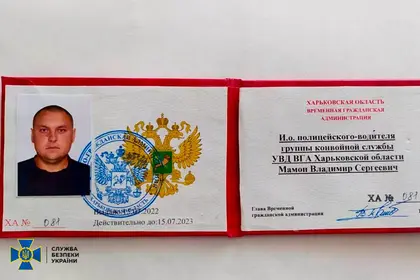The Security Services of Ukraine (SBU) has identified two brothers it says helped plan the devastating Russian missile attack on a wake in Hroza last week which killed 53 people.
Thirty-year-old Volodymyr Mamon and his younger brother, Dmytro, 23, were local residents in the village who “during the occupation of the region went over to the side of the Rashists,” the SBU said in a post on Telegram.
JOIN US ON TELEGRAM
Follow our coverage of the war on the @Kyivpost_official.
Dmytro was a traffic policeman, while Volodymyr was a police escort driver under the occupying authorities, according to documents posted by the SBU.
The two men are alleged to have fled to Russia when Hroza was liberated by Ukraine in September of last year, where they began to remotely cultivate a network of informants.
“Under the guise of friendly conversations and correspondence in the messenger, the traitors asked people for information about the deployment of the Defense Forces and mass events in the region,” the SBU claims.
Recently, much of the information reportedly gleaned by the brothers was information about the reburial of a soldier who had been killed a month after Russia launched the full-scale invasion of Ukraine.
They then allegedly passed this information onto Russian forces which then used it to strike the gathering with an Iskander missile.
“[The brothers] understood that as a result of an enemy attack, civilians – their acquaintances from the village of Hroza, including those who provided them with information – would surely die,” the SBU said.

EU Transfers €1.5 Bln Raised From Russian Assets for Ukraine
The SBU also released pictures of the brothers’ documents as well as screenshots of phone conversations purporting to show how they collected information.
A spokesman said the SBU was attempting to locate the men and bring them to justice. An investigation by Radio FreeEurope/Radio Liberty last year reported that Volodymyr Mamon drove a car with the pro-Russian "Z" sign during the occupation, delivered provisions to Russian soldiers at checkpoints, looted and searched for Ukrainian soldiers.
He is currently on trial in absentia in a court in Poltava for high treason.
The SBU concluded: “On the basis of the collected evidence, the investigators of the Security Service charged both defendants with suspicions under Part 2 of Art. 28, part 2 of Art. 111 of the Criminal Code of Ukraine.
“In addition, the criminal actions of Volodymyr Mamon are additionally qualified under Part 5 of Art. 27, Part 2 of Art. 28, part 2 of Art. 438.”
In Hroza on Monday, grieving families buried their loved ones. Some 30 graves had already been dug for burial at the cemetery in the small village which now numbers around 330 inhabitants, down from 500 when the conflict began.
Four of the victims were laid to rest on Monday, following three burials over the weekend.
Last Thursday the village – which survived Russian occupation between February and September 2022 – endured one of the deadliest strikes of the war.
After the deadly attack, rescue workers recovered several dismembered or decapitated bodies, bearing witness to the force of the explosion of the missile.
According to a police source in Kharkiv, a city further north where the remains were transported for the investigation, three bodies remain unidentified.
You can also highlight the text and press Ctrl + Enter






